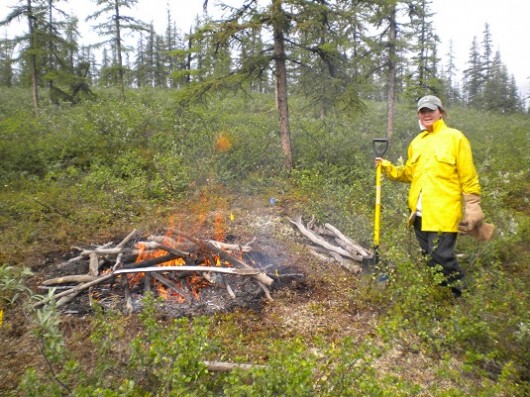As part of my NSF-Funded Post-Doctoral Fellowship, I have spent the last year talking with colleagues and friends to try and determine the best approach for conducting plot-level experimental burns in the larch forests of far northeastern Siberia. Today, all that planning and strategizing finally paid off. With the help and expertise of Nikita Zimov (Northeast Science Station), a group of us, including Peter Ganzlin, Brandi Jo Petronio, Sue Natali, Logan Berner, Lindsey Parkinson, and Ludda Ludwig successfully ignited 12 fires of varying severity in a mature, low-density larch stand. We set these fires to try and better understand how variations in fire severity affect the soil organic layer-the layer of dead mosses and roots that lie atop the mineral soil. We are interested in fire effects on the soil organic layer (SOL) because it serves two very important purposes: 1) it insulates the underlying permafrost and protects it from thawing, and 2) it is the seedbed for larch trees. Most climate models predict that fire severity will increase as climate continues to warm and dry. If this happens, more of the SOL will be burned by fires. Less insulation by the SOL could lead to thawing permafrost, making carbon stored in previously frozen soils available for microbial use. If the soil microbes use this carbon for their growth, they will release CO2 as a by-product. Because CO2 is a greenhouse gas, this could amplify climate warming. A reduction in the SOL could also alter the ability of larch seeds to germinate. Any changes in germination and seedling growth, ultimately affecting the amount of carbon stored in larch trees.

Showing off my high-severity burn treatment.
In the upcoming days, I will measure how much these different fires affected the SOL depth and a variety of other soil parameters. Sue Natali, post-doc at the University of Florida, will quantify changes in ground layer respiration, and Ludda Ludwig, an undergraduate at St. Olaf, will measure changes in microbial enzyme activity, which is a proxy for how hard soil microbes have to work to the organic carbon and nutrients necessary for their growth. Just prior to the first snowfall, Sergey Davydov at the Northeast Science Station will sow larch seeds onto the plots so I can determine their germination when I return next summer. We will continue to monitor these plots during the next few years to better understand how fire severity influences vegetation regrowth and characteristics of permafrost soils.




Comment(1)-
Michael Mahala says
July 11, 2012 at 5:54 pmYes! Yes! Yes! Very glad to read the burns were successful. One question: Where are the marshmallows?